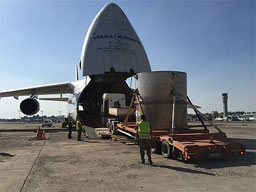(Occupational Health and Safety) — Uzbekistan became free from high enriched uranium (HEU) on Sept. 24 when irradiated liquid HEU fuel was removed from a research reactor located at the Radiation and Technological Complex in Tashkent and transferred to the Mayak reprocessing facility in the Russian Federation, the IAEA announced.

- (Photo: NNSA)
“The liquid HEU removal operation represented the latest accomplishment in a global program involving the IAEA, the Russian Federation, and the United States to assist several countries, including Uzbekistan, in eliminating the risks associated with HEU”, said Peter Hanlon, assistant deputy administrator for the Office of Material Management and Minimization in the U.S. Department of Energy’s National Nuclear Security Administration. Advertisement
IAEA is supporting Member States’ efforts to replace HEU with low enriched uranium in research reactors worldwide for achieving their non-proliferation objectives, now that low enriched high density fuel is available to maintain the performance of many research reactors previously operated with HEU fuel. “This operation represents an important step in efforts to minimize the use of HEU”, said Juan-Carlos Lentijo, director of Nuclear Fuel Cycle at IAEA. The Tri-partite (IAEA-USA-Russian Federation) Initiative, also known as the Russian Research Reactor Fuel Return (RRRFR) Program, carried out the shipment.
IAEA reported that the shipment from the IIN-3M FOTON was “the first removal operation of irradiated liquid HEU fuel and represents a historic milestone for the RRRFR Programme, which has facilitated the transfer of nearly 2160 kilograms of former USSR-supplied HEU from 14 countries to Russia in 61 shipments […] Ten of the 14 countries are now free of HEU fuel.” The research reactor was a rare reactor type in which the fuel and the moderator are mixed together to form a homogenous liquid; according to IAEA, it could operate in a steady-state power level or pulsed to different peak power levels, had been in operation since 1975, and was used for the testing of semiconductors and other devices.
The Government of Uzbekistan decided to decommission the reactor along with the rest of the Radiation and Technological Complex and approved the strategy of immediate dismantling with subsequent unrestricted use of the site. Decommissioning is anticipated to take about 32 months to complete.

